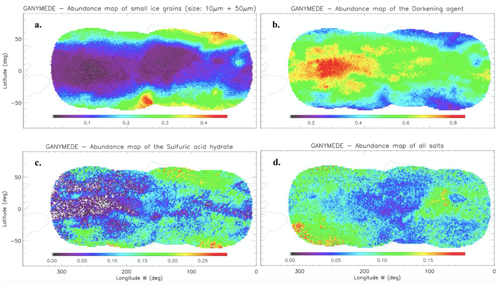Pending the JUICE/ESA mission … surface composition and properties of Ganymede from near-infrared ground-based measurements
- 1School of Physical Sciences, The Open University, Milton Keynes MK7 6AA, UK
- 2Applied Physics Laboratory, Johns Hopkins University, Laurel, MD 20723, USA
- 3Institut d'Astrophysique Spatiale, Université Paris-Saclay, 91405 Orsay Cedex, FRANCE
- 4Geological Sciences & Engineering, University of Nevada, Reno, NV 89557, USA
- 5Jet Propulsion Laboratory, Pasadena, CA 91109, USA
- 6School of Physics and Astronomy, University of Edinburgh, Edinburgh EH8 9YL, UK
Icy bodies are the most numerous and diverse bodies in the Solar System, but only a few have been visited or will be visited by a space probe. The Galilean satellites are one of those, especially Ganymede which is the primary target of the future L-class mission JUICE (launch scheduled in 2022) in ESA’s Cosmic Vision programme. Ganymede's surface visually exhibits an important geological diversity, with young bright areas to older dark terrains. This diversity also expresses itself through the moon’s surface composition, which was studied extensively in situ by the NIMS instrument of the Galileo mission (NASA) in the late 90s; like the majority of giant planet satellites, Ganymede's surface is dominated by H2O-ice and some non-icy components, very likely hydrated salts based on the distorted shape of the spectral signatures (McCord et al., 2001). However, this binary composition has been obtained with a spectral sampling (~25 µm) not allowing to detect specific absorptions for the non-icy materials, thus not allowing their identification. Hence, many questions about Ganymede’s surface composition remain unanswered while important technical advances have been made since.
In preparation of the JUICE mission, and specifically of the near-infrared imaging spectrometer MAJIS of the JUICE mission, a ground-based campaign was performed using an instrument with a much finer, i.e. better, spectral sampling: SINFONI (SINgle Faint Object Near-IR Investigation). SINFONI is installed on the UT4 of the Very Large Telescope (VLT hereafter) at the European Southern Observatory (ESO hereafter) in Chile. It combines one adaptive optics module and an integral field spectrometer operating in the near-infrared covering from the beginning of the J-band (~1.1 µm) to the end of the K-band (~2.45 µm). Here we present the results derived from the analysis and the modeling of four observations acquired at different dates, from October 2012 to March 2015, all covering the 1.45 – 2.45 µm wavelength range with a spectral resolution about 0.5 µm and a spatial sampling of 12.5 x 12.5 mas2. These results were recently published in Icarus (Ligier et al., 2019).
The first result we obtained concerns the physical properties of Ganymede’s surface. Indeed, the data reduction process highlights that the Lambertian model is not sufficient to remove the photometric effects due to observations geometry. Instead, the Oren-Nayar model (Oren & Nayar, 1994), which generalizes the Lambertian law for rough surfaces, produces excellent results where no inclination residuals are observed up to inclination angles around 65°. The quality of the photometric correction is thus used as proxy to infer Ganymede’s surface roughness: from 16° ± 6° to 21° ± 6° depending on the observations.
Then, concerning the surface composition of the moon, our modeling confirms that it is dominated by H2O-ice, predominantly the crystalline form. The abundance maps of the ice show two main patterns: (1) a latitudinal gradient in terms of abundance, with large polar caps, and (2) a latitudinal gradient in terms of grain size, where the smaller grains (>50 µm) are located at the highest latitudes, showing a sharp transition around ±35°N coinciding with the transition between open and closed field lines of Ganymede’s own magnetic field (figure 1a). Ice sublimation explains this distribution, redistributing H2O-ice from the “hot” equator to the colder poles, very likely redeposited as finer grains.
Apart from the ice, another major compound is required to fit Ganymede’s spectra: a darkening agent. Similarly to previous studies, this darkening agent could not be identified, but we were able to provide new constraints on it. First of all, this unknown material cannot be organic matter since its reflectance level, about 0.25, is more or less five times higher than that of organic matter. Instead, the reflectance level suggests a silicate-type material, as already mentioned in a previous study about Callisto (Calvin & Clark, 1991). Its abundance map shows the highest abundances (up to 0.85) at equatorial latitudes in the trailing hemisphere (figure 1b). The well-known surface sputtering engendered by Jupiter’s magnetosphere is the simplest process to explain such distribution. Even with the magnetic field of the moon, it is possible for corotating singly-charged ions to become neutralized near the moon and continue to the surface as neutrals, sputtering mostly around the trailing apex.
Last but not least, our study highlights the necessity of secondary species, i.e. >10% overall, to better fit the measurements: sulfuric acid hydrate and salts, likely sulfates and chlorinated. While the sulfuric acid hydrate is, like H2O-ice, mostly located at high latitudes (figure 1c), the abundance map of the salts shows a heterogeneous distribution which seems neither related to the Jovian magnetospheric bombardment nor craters (figure 1d). These species are mostly detected on bright grooved terrains surrounding darker areas. Endogenous processes, such as freezing of upwelling fluids going through the moon’s ice shell, may explain this heterogeneous distribution.

How to cite: Ligier, N., Paranicas, C., Carter, J., Poulet, F., Calvin, W., Nordheim, T. A., and Snodgrass, C.: Pending the JUICE/ESA mission … surface composition and properties of Ganymede from near-infrared ground-based measurements, Europlanet Science Congress 2020, online, 21 September–9 Oct 2020, EPSC2020-655, https://doi.org/10.5194/epsc2020-655, 2020

